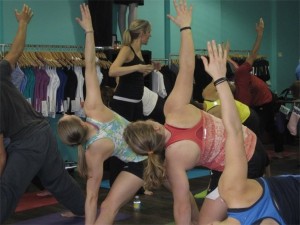Do you ever find yourself needing to communicate an important new idea or concept so that it is understood quickly? Yoga instructors are the best at communicating complex ideas. They use all of the tools in the toolbox. You have to get it. If not, you might get hurt. Yoga instructors try to communicate a complex idea to you so that you take action on it right there and then. The concept they convey is a yoga pose that you need to situate your body into. You need to get it quick too, because you will be done with that pose and onto the next one in less than a minute.
 Here are some things I’ve learned from yoga instructors on communicating your idea. Let’s say that the instructor wants you to hold a pose where you put your feet into the ground, stretch your gastrocnemius muscles, bend at the hips, straighten your back, separate your shoulders out, slightly bend your arms, plant your fingers into the floor, all while breathing deeply and focusing your mind just on the present moment of the pose. They know better than to just tell you to do that in the words I just used. This is too complicated. Many also know better than to ask you to do Adho Mukha Svanasana. That is a Sanskrit pronunciation. Do you know Sanskrit? I didn’t think so.
Here are some things I’ve learned from yoga instructors on communicating your idea. Let’s say that the instructor wants you to hold a pose where you put your feet into the ground, stretch your gastrocnemius muscles, bend at the hips, straighten your back, separate your shoulders out, slightly bend your arms, plant your fingers into the floor, all while breathing deeply and focusing your mind just on the present moment of the pose. They know better than to just tell you to do that in the words I just used. This is too complicated. Many also know better than to ask you to do Adho Mukha Svanasana. That is a Sanskrit pronunciation. Do you know Sanskrit? I didn’t think so.
Here is where it gets good. The instructor has to help you get this complex idea within seconds. So, luckily these yoga poses were named well. They were named using the power of metaphor. Adho Mukha Svanasana means “downward-facing dog.” Even before I did my first yoga pose my mind conjured up an image of man’s best friend stretching out in the way they love best. I knew what this seemingly complex movement, Adho Mukha Svanasana, generally looked like because I had seen a downward facing dog stretching before! That image was in my mind…the word Adho Mukha Svanasana wasn’t. The yoga instructors use the power of metaphor to describe the pose to help you understand what it might look like. These poses were named well. Take a look at the names of some of the classic yoga poses, you will see they translate into metaphors…and you might guess how to do them.
Sanskrit Word—–>English Translation (Metaphor)
Adho Mukha Svanasana—–> Downward-Facing Dog
Ardha Chandrasana—–> Half Moon Posture
Bakasana—–> Crane Pose
Balasana—–> Child’s Pose
Bhujangasana—–> Cobra Pose
Chakrasana—–> Wheel Posture
Dhanurasana—–> Bow
Halasana—–> Plow
Padmasana—–> Lotus Pose
Utkatasana—–> Chair
Vriksha-Asana—–> Tree Pose
The metaphor may help the person doing yoga get the general idea. What is needed though is something to help them get the details. Here is how the yoga instructors help them do this. First, they show you. They will demonstrate the pose up front and talk you through it. You watch and do.
If showing you themselves isn’t enough the yoga instructor has constructed an environment in the studio to help you learn from others. You are in close proximity to them, sometimes only inches away. You do yoga with other people that know these poses. If you are still confused they encourage you to look at the person in front of you that knows what they are doing. They utilize the power of others as co-teachers. You watch others and learn.
If you still don’t get it the instructor will talk you through it. They give you specific feedback on what it is that you need to do that you aren’t doing. It is laser focused. They again use the power of metaphor by perhaps sharing an analogy to coach you through it and help you understand, such as “hinge at the hips” or “plant your hands into the mat” and “root down.”
Finally if you still don’t get the idea the instructor will use the greatest tool they have. The hands-on adjustment. They will come over to you and physically help move you to where it is you need to go. Sometimes we just don’t get it. This guarantees we will get it. There is so much to get.
Yoga instructors use the tools of metaphor, demonstration, letting you observe and learn from others, focused feedback, coaching with analogies, and hands-on adjustment to help you learn & do something complex like Adho Mukha Svanasana. The next time you have an important idea or concept to communicate to someone for the first time, think about how a yoga instructor might help that person learn and do.